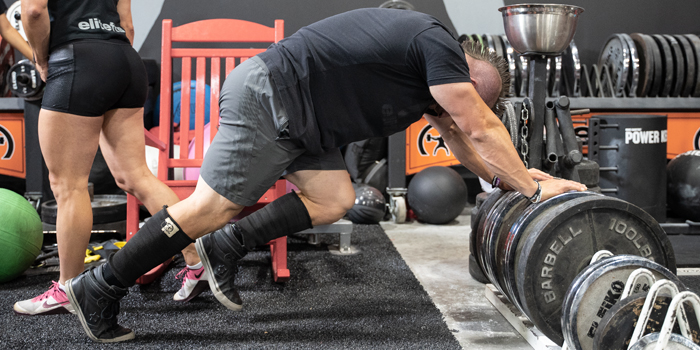Achieve Your New PR: Testing the 1 Rep Max
Written by the Boostcamp staff
Test Your Limits: Achieving Your 1 Rep Max PR
Preparing for a personal record (PR) lift in competition or for leisure, and whether it's a squat, barbell bench press, or deadlift, requires careful preparation and attention to detail. It's not just about showing up at the gym with a gym bag full of your belt and your knee sleeves, and hoping for the best. What are the steps to help you hit a new PR lift? What type of workout routine should you be using? From your pre-gym routine to the actual workout, while also finding out the maximum amount of weight you can push, squat, or deadlift – your one-repetition maximum (1RM) – which is considered the gold standard in measuring a person’s physical strength.
Calculating your one-repetition maximum (1RM) with the correct technique is crucial in determining the maximal weight you can lift for a single repetition of a given exercise, allowing you to set realistic goals and track your progress effectively. To lift safely and accurately determine your one-repetition maximum (1RM), it is recommended to use a rep max calculator, such as the one created by the University of New Mexico. Knowing your 1RM is particularly useful for athletes who compete in a strength sport or competition, such as powerlifting or Olympic weightlifting. When it comes to bodybuilding however, the training style is focused on volume and intensity with the goal of hypertrophy, rather than strength.
In both powerlifting and Olympic weightlifting, the goal is to lift the most weight for just one rep. In other words, it’s fundamental to know your one-repetition maximum (1RM) so you can decide which weights to lift in competitions and during practice. The table below can help you convert the percentage of your 1RM to a different way of measuring, such as using your 3RM or 6RM. This allows for variation in training programs and provides a different way to gauge your strength and progress.
Pre-Gym Preparation
Nutrition and hydration
Start preparing for your PR lift at least the night before. Eat a big, carb-heavy dinner and ensure you are well-hydrated. Continue to eat nutritiously and hydrate throughout the day leading up to your workout, with a focus on consuming enough sodium and carbs to fuel your body.
Sleep for a new PR
Make sure to get a good night's sleep the night before your workout. This will help ensure your body is well-rested, fully recovered, and ready for the demands of a heavy lift.

Warmup for a new PR
Warmup exercises
Before beginning your PR lift, perform a thorough warmup to activate your muscles and loosen up your body. For deadlifts and squats, this may include banded rows, glute-ham raises, good mornings, or walking with a hip circle. For bench press, this may include tricep extensions, lat pulldowns, pull-ups, explosive push-ups, and accessory movements commonly used by serious lifters. The specific warmup exercises will depend on your chosen lift and personal preferences.
Consistent technique
As you perform your warmup sets, pay close attention to your technique. Approach each set with the same intensity and focus as if it were your PR lift. This will help build good habits, a mind-muscle connection, and ensure that your technique remains consistent as the weight gets heavier.
Weight jumps
Plan your weight jumps during warmup sets strategically. You should have a target weight in mind for your PR lift, and the jumps should make sense based on that goal. Make sure to take the same weight jumps each time you work up to your target weight in order to become familiar with the process and determine how much weight you can handle for your 1RM. Also, it is important to select an initial weight that is within the subject’s perceived capacity (~50%–70% of capacity) and progressively increase the resistance and overload the muscles by 2.5 kg to 20 kg until the subject cannot complete the selected repetition(s) with heavy loads. All repetitions should be performed at the same speed of movement and range of motion to instill consistency between trials. Rest periods should remain at 1-5 minutes between each single attempt and load increments typically range between 5-10 % for the upper-body, and 10-20 % for the lower-body exercises. 1RMs should be achieved within 3-7 attempts.
Mental preparation
Stay focused and calm during your warmup sets. A huge part of powerlifting is having a good mindset, so you should avoid getting overly excited or nervous as this can affect your technique. Channel your excitement internally and maintain a clear mind.

The PR Lift (New 1 Rep Max)
Maintain technique and intensity
When attempting your PR lift, remember to apply the same technique and intensity used during your warmup sets. Keep your focus and concentration on the task at hand.
Hype song and smelling salts
Choose a hype song that gets you pumped up for your PR lift, and consider using smelling salts for an extra boost. If you've never used smelling salts before, don't try them for the first time during an important lift, as they can be intense.
Execution and success
If you've followed the steps above, you should be well-prepared for your PR lift. Execute the lift with confidence, knowing that your preparation has set you up for success.

FAQ
How do I prepare for a new PR like a squat, bench press, or deadlift?
Start preparing at least the night before by eating a carb-heavy dinner, staying hydrated, and getting enough sleep. Continue focusing on nutrition, hydration, and proper warm-up exercises on the day of the lift.
What should I eat the night before hitting a new PR?
Eat a big dinner that's high in carbohydrates to ensure your body has enough energy for the upcoming workout.
How much sleep should I get before a new PR?
Aim for a sufficient amount of sleep, as it plays a significant role in your performance. The exact duration may vary, but generally, 7-9 hours of sleep is recommended for adults.
What should my nutrition look like on the day of a big lift?
Focus on consuming a balanced breakfast and snacking throughout the day to maintain your energy levels. Stay hydrated by drinking water, Gatorade, or other hydrating beverages.
How should I warm up for a new PR?
Perform exercises that target the specific muscles you'll be using in the lift. For deadlift, this may include banded rows, glute-ham raises, good mornings, or hip circle walks.
How should I approach the bar during my warm-up sets?
Treat each warm-up set with the same intensity and technique as if it were a heavy set. This helps build good habits and prepares your central nervous system for the lift.
How can I maintain proper technique during my warm-up sets?
Focus on your foot placement, body positioning, and lifting cues for each set. Consistent technique helps reduce the risk of errors when attempting a heavy single.
How should I plan my weight jumps during my warm-up sets?
Choose weight jumps that make sense for your target number and follow a consistent pattern. This will help you get familiar with the appropriate weights for each stage of your warm-up.
How can I mentally prepare for a new 1RM?
Stay calm, don't get overly excited, and remember the technique and intensity you used during your warm-up sets. Focus on your lifting cues and avoid overthinking the lift.
How can I maximize my focus and energy before attempting a heavy single?
Choose a hype song to listen to and use smelling salts, such as ammonia, to increase alertness. However, do not use ammonia for the first time during an important lift, as it may be too intense.
Where to Find a Good Program
When it comes to finding a good program to help you build up strength, muscle mass, and overall prepare for hitting a one rep max, check out the free Boostcamp App. You can find tons of different workout routines that will truly push you to the limit, and they are made by renowned evidence-based coaches. Boostcamp also lets you create your own custom routines and log your progress, which is great for tracking your progress and making linear progression.
To maximize your gains and simplify your fitness journey, consider using Boostcamp, the last lifting app you'll ever need. Boostcamp helps you track your progress, offers customizable training programs, and provides expert guidance to ensure you get the most out of your chosen workout program whether it's linear push pull legs or upper lower or whatever you choose. Start making the most of your workouts and download Boostcamp today!
Conclusion
Preparing for a new PR lift goes beyond just the workout itself. It involves proper nutrition, hydration, sleep, and a focused warmup. By following these steps, you'll be well-equipped to tackle your PR lift with confidence and achieve success. Remember that consistency in your technique and mental preparation is crucial in helping you reach your goals.
Be sure to follow Boostcamp on Instagram and subscribe on YouTube!

